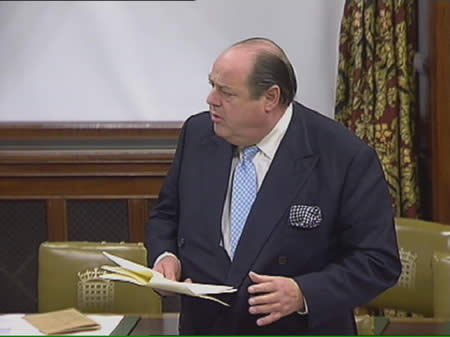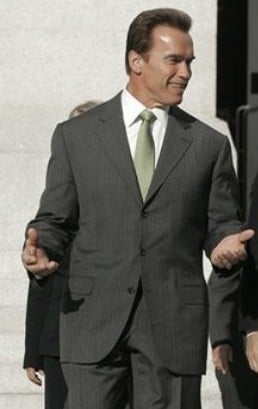
Men come in all shapes and sizes, and for every man there are fabrics and styles that best compliment his individual body type. A tall man in an overcoat wants to look regal, not like a giant. A short man in a suit wants to look professional, not like a kid wearing his older brother’s clothes. A large man wearing a blazer seeks to project a stately image, not of a sack about to burst at the seams. All men want to be taken seriously; to ensure our audience does not focus on our physical flaws, it’s important that we de-emphasize them. Let me be clear – no suit is going to hide 100 pounds of excess weight; you can, however, minimize the attention paid to certain physical features and thus downplay their significance. A large man will look big, but he doesn’t have to look fat.
Please note – In an effort to eliminate redundancy, I will state now that every man could improve his appearance with the help of a skilled tailor. A tailor with both talent and an eye for style is rare – if you find one, build and maintain this relationship. Also for this article I focus on working with what a man currently has; diet and exercise, although the ideal solution for many, are not considered here.
The Man of Average Build
The man of average build is neither tall, nor short; neither too heavy, nor too thin. He does not have huge muscles, and most clothing seems to just fit him off the rack. He is the average man, and he is fortunate in that almost anything looks great on his frame. If you are in this category thank your parents, dress neatly, pay attention to your complexion/fabric combinations, and wear the right clothing for the occasion.
The Tall Man
The first important choice a tall man has to make about a suit is what type of fabric will it be made from. Both checks and windowpane fabrics are excellent choices – besides being both unique and classy, the horizontal lines of these patterns help the tall man appear more substantial. Tall men can still wear stripes, but they should consider patterns that are spaced farther apart and have some weight to them such as chalk stripes (vs. thin pin stripes).
Garment style features that help the tall man look more proportional include a ticket pocket (a smaller pocket above the right side pocket on the jacket), larger trouser cuffs (try 1 7/8 inches), a jacket that’s ¾ to an inch past the bottom curve of the backside (to help cut the leg line), and details such as pocket squares and a boutonnière. Individually each of these has only a small effect, but together they work to break up the vertical lines which make tall men look abnormal. Overall the key to a tall man looking proportionally sound is to ensure that his clothing is built relative to his size. Thus when choosing a garment he should look at details like the pocket flaps and lapel widths and ask himself whether they appear too small for the garment they are attached to.
A great example of a modern tall man who downplays his height is Tim Robbins. At 6′ 5â€, he is one of the tallest actors in the world. But most of us don’t pay attention to his height; instead we focus on his acting. And that’s the purpose of wearing clothes that proportion you correctly – to ensure the focus is on you and your talents, not your height.
The Short Man
The problems of the short man are in many ways the opposite of those the tall man faces. Where as a tall man wants eye catching detail, the short man should seek to streamline his outfit as to allow an observer a smooth path from the shoes to the face. Short men should avoid horizontal lines; whether they be in the fabric of his suit or in the subtle line drawn across his chest with a square pocket fold (instead opt for a double point fold). Vertical lines, especially thin ones close together, should find their way into your wardrobe. Solid fabrics are perfectly fine, especially dark colors that have a slimming effect, but a man shorter than average should be careful of textured solids such as plaids and bird’s eyes that cause the eyes to fixate vs. moving smoothly up and down.
A problem specific to the short man is that his head often appears a bit larger than it should in proportion to his body; to compensate, he should not only build out his jacket’s shoulders but also ensure his hair style does not exaggerate his head’s width. The short man is helped immensely by always wearing a matching jacket and trousers (a light/dark combination only serves to cut you in half) and he should ensure his jackets are cut as short as possible (just covering the bottom curve of his backside). Too much room in the crotch area is especially bad – it only makes short legs look shorter and the trouser rise should be paid close attention to when shopping. Finally, the short man should consider wearing his pants at their natural waist and moving to suspenders vs. belts. Doing this increases the apparent length of his legs, encourages him to keep his jacket on, and is considered by most who have made the switch to be more comfortable.
The Heavy Man
 British Parliament Member Nicholas Soames
British Parliament Member Nicholas Soames
Men whose waists are larger than their chests face the problem of finding clothes that do not make them appear larger than they actually are. Oftentimes what fits the heavy man in the shoulders is too small in the waist; therefore, the large man should seek a jacket with a generous cut and a flattering drape. Do not try to wear form fitting clothing; it’s better to have a loose fit around the midsection that says nothing than tight bunching that screams excess girth. The heavy man cannot conceal his size, but his clothing can serve the purpose of refocusing his observers’ attention to his face.
Vertical lines and dark solid colors are a friend of the heavy man. As mentioned before they create the illusion of height and thin the silhouette, and anything that stretches you in height helps with lessening the appearance of the midsection. Again, no fabric or pattern will make the large man look thin – but the right choice here will allow him to move about without drawing comment.
As for style, the heavy man should lean towards two button jackets with a deep “V†to help elongate the chest. Peak lapels on a single breasted suit can create more vertical lines (and their width helps the suit’s proportions), as do large slanted side pockets. Like the short man, a man with a large midsection is best served when he wears trousers higher than his hips. Instead of his trousers “squeezing†him, they drape over the bottom of the stomach and create the illusion of longer legs. For the large man who hasn’t discovered suspenders, please stop reading this and seriously explore this option.
The Thin Man
Thin men need to add weight to their bodies, and the fabric they choose is vitally important. Horizontal lines are a thin man’s friend, and textured fabrics such as tweeds and glen check will help add some substance to his frame. A thin man should be mindful of his clothing’s fit – too slim of a cut will only accentuate his narrow frame while too loose of one will exaggerate his lean structure.The thin man should look to overlap fabric in subtle ways such as with a double breasted jacket and double pleated trousers with cuffs. He should pay attention to his shirt’s fit, specifically in the neck (two finger allowed) and wrists (a man should not be able to slip his cuffs off without unbuttoning them). Details such as a pocket square and a medium spread collar will help give him a little more heft. Even his grooming can make a difference – allowing a little more hair to grow on his head can make a dramatic difference.
 Image from Bbrhuft
Image from Bbrhuft
Actor Daniel Day Lewis is a perfect example of a thin man who has used all of these tactics to increase the weight of his appearance. Do a Google search on him and you’ll see his use of checks, layers, and longer hair (if you think I’m joking here, look at how much thinner he looks as a bald man!)
Combinations
Many hard to fit men are a combination of the above body types – the below short descriptions emphasize import issues facing these gentleman.
Tall & Heavy
The key here is proportion – you are a big man, and you want all aspects of your clothing to be a bit larger. Ensure your jacket pockets are proportional and the cut on your lapels are generous. Reduce the padding in your shoulders to avoid looking like a linebacker, and you can skip the check patterns and opt for solids and thick stripes.
Tall & Thin
The tall and thin man needs to be very conscious of his clothing’s fabric and fit, as that most of the shirts and trousers out there will make him appear like a lanky stork. Take the advice about checks and fabric texture to heart; seriously consider a double-breasted suit and heavier fabrics if the weather permits.
Short & Stout
One of the hardest profiles to find clothing for, fit is imperative for the short and stout, especially if the man is muscular. You should always stick with solids and stripes, and avoid contrasts in your clothing combinations that create vertical lines (a navy blazer with light colored khakis is a bad idea here). Baggy clothing is also undesirable; instead, aim for a lean, straight silhouette that will enhance your height. Many argue for double vents for the short man’s jacket; however, for the short and stout, I recommend no vents. Although not as versatile (no putting your hands in your pockets), the no vent jacket option is the most slimming with no risk of a flap flaring out like a tail.
Short and Thin
Small men need to ensure their clothing is proportionally smaller, not just a larger cut made to fit their frame. Oversized lapels, cuffs that are too large, and jackets lengths that are too long, do not flatter the small man; instead, they only make him look even smaller. Beware of the quick fix on trousers where a tailor only shortens the pant legs – the result is a pair of trousers with a low rise that makes your legs look short and a trouser cuff size too large for your feet (your cuff should cover 2/3 to ¾ of your shoe).
The Muscular Man (Both Top and Bottom Heavy)

Most men have a drop (difference between chest and waist circumference) of only a few inches. Muscular men however often have a much more substantial drop, in many cases closer to 10 inches. As a result they face a unique set of problems.
Suits that fit a muscular man in the shoulders and chest are hopelessly too large in the stomach, and even when he does find something that can be tailored, he runs into the issue of his lower body looking like an afterthought. The muscular man wants to downplay his upper body while increasing the presence of his lower half with the intention of creating a unified, natural look that only hints at his muscular underlay. Starting with the jacket, the muscular man wants very soft shoulders with minimal padding. Larger lapels are in order to make his larger chest appear more proportional; peak lapels are a great option here. Avoid the tendency to suppress the waist, a man’s figure should not be shaped like an hourglass. For weightlifters and men with extreme drops, a slightly longer jacket can be employed to better hide a steep V shaped torso. Pleated trousers with ample room in the seat will help give a more weighted look to the hips, while a heavier shoe with some design (such as a wing tipped brogue) and a slightly smaller trouser with a larger cuff can help make the lower body appear better proportioned.

Another muscular profile, with the complete opposite problem, is the futbol/soccer player silhouette – a lean upper body with a large muscular lower body. For men such as this, I recommend trousers carefully tailored around the hips (you want to ensure they are not too tight, otherwise pockets will bulge out and the wearer may even tear them with a quick jerk) and a jacket with no vents (a large backside can cause flaring on a double vent….but if cut properly it is a viable alternative).Finally, these men are best served by keeping their jackets on and thus their prominent backsides covered.Sorry ladies.
Written by
Antonio Centeno
President, www.ATailoredSuit.com
Quality Custom Clothing & Sound Style Advice
Join our Facebook Page for a chance to Win Custom Clothing


